Bigfoot’s Killer-N 1102 Wireless Networking vs. the World
by Jarred Walton on August 10, 2011 10:38 AM ESTWhat about Wired Ethernet?
So far, we’ve skipped discussion of wired Ethernet performance. There are two major reasons for this. First, if you’re interested in wireless performance, it’s probably because you don’t want to bother running wires around your house/office, so regardless of how fast Ethernet might be, it’s probably not something you want. The second reason for not including Ethernet is that Gigabit Ethernet is so much faster than even the best current wireless solutions that it tends to make the charts hard to read. But let’s just see how Ethernet—both 100Mbit and 1000Mbit—stacks up against our best-case results from earlier. We’ve pulled the best results for all of the other wireless cards from either router, so we’re using the Netgear results or the Linksys results as appropriate. Even with that advantage, there are many tests where Ethernet still stomps all over wireless.
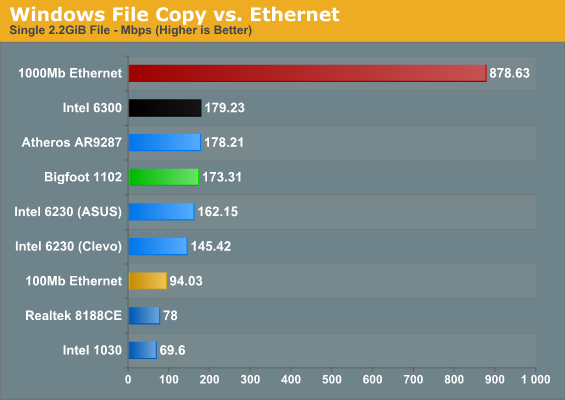
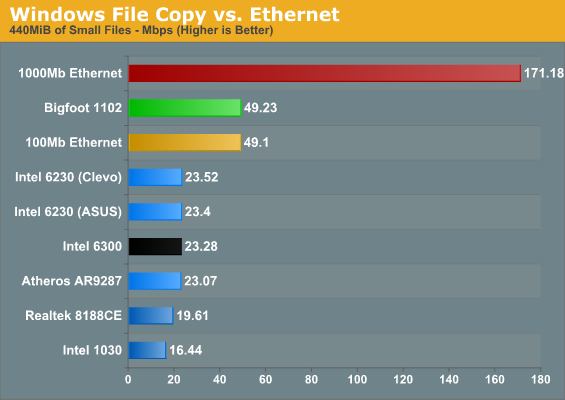
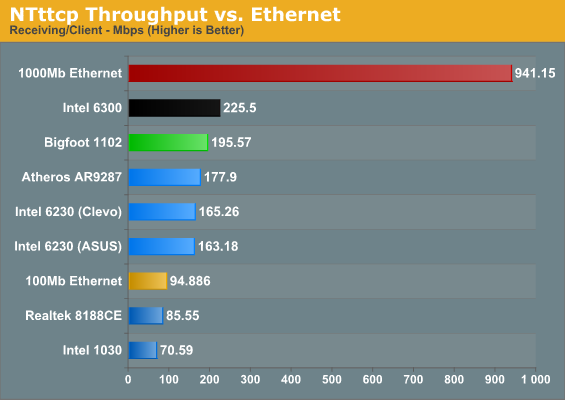
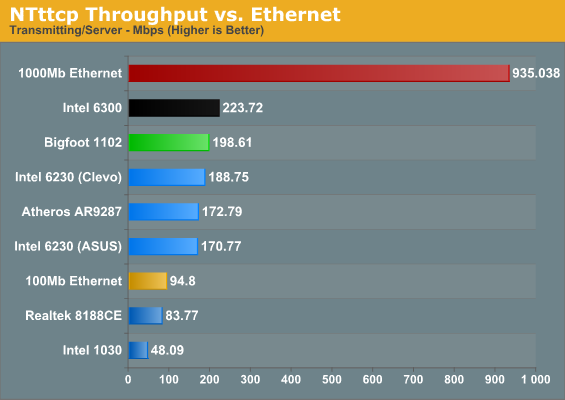
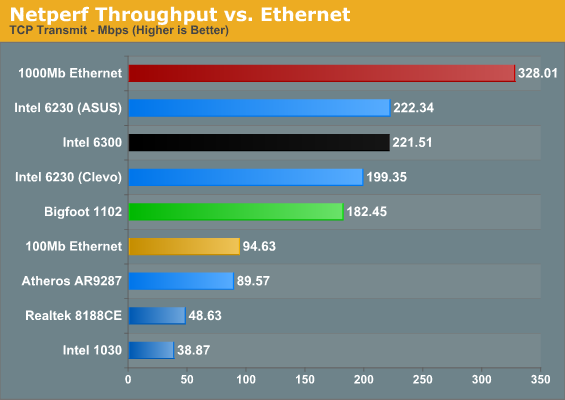
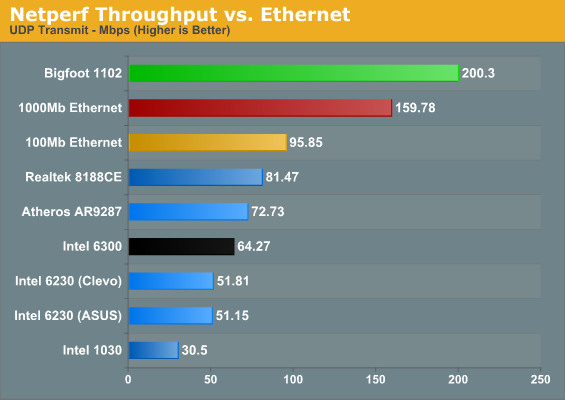

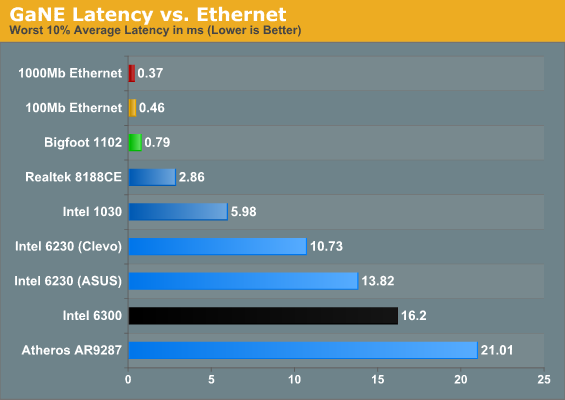
The first area where a wired connection is clearly superior is in latency—even 100Mbit Ethernet trumps the Bigfoot 1102, and that translates into a virtual tie for copying lots of small files. Gigabit Ethernet runs away from everything else, but that’s expected. It’s about an order of magnitude faster than the lesser wireless adapters, and even the Bigfoot and Intel 6300 can’t come close to the bandwidth and latency a wired connection provides. The GbE connection is 3.5 times faster than the Bigfoot for copying lots of small files, and in bandwidth limited situations it ends up being roughly five times as fast. The only test where GbE falls short is in our Netperf UDP result, but I’m still not entirely comfortable with the Netperf figures.
In short, you can pry my Gigabit Ethernet from my cold, dead hands—but then, I routinely install nearly 100GB worth of data over a wired connection for each laptop I test, and that’s not something most users need. For any laptops castrated by the inclusion of 100Mb Ethernet (Toshiba, I’m looking at you!), a good 802.11n card can actually offer a better overall experience. Of course, you’ll also need to consider your choice of router in some situations—I demand Gigabit Ethernet support for instance, and after using a 5GHz capable router I’m ready to upgrade.
Something else you don’t immediately get from the charts is the ease of setup: for Ethernet, you plug in the cable and you get your 100Mb or 1000Mb connection; there’s no fussing about or worries of Interference. Longer cables can increase latency slightly, and if you bounce through several switches you can end up with 3-5ms of latency, but throughput is still much faster than any 802.11n network. Wireless networking also tends to need more overhead for error checking and interference losses, and there’s a question of whether the streams are linearly independent enough to get higher throughput, orientation, directionality of signal, etc. Even though you might connect at 450Mbps or 300Mbps, you’ll never actually reach anywhere near that level of throughput. In our testing, the highest throughput we ever saw was around 75% utilization of the available bandwidth, and that was on a 300Mbps connection. For the 450Mbps Intel 6300, we actually topped out at just 50% utilization. By comparison, 100Mb Ethernet reached up to 96% utilization and 1Gb was only slightly lower at 94% utilization. (Note that a better router could improve the situation, as Brian managed up to 300Mbps throughput in a couple of his tests with the Airport Extreme and a MacBook Pro—though that could also be coming from some Broadcom-to-Broadcom optimizations and/or OS X.)
Another item to mention is that if you use switched Ethernet, you also get a true 100Mb/1Gb connection even when there are multiple computers accessing the network, and it’s a full duplex connection so you can send and receive at up to 1000Mb if needed. Try accessing a lot of data over a wireless network from two different laptops and you’ll find performance tanks. We did some quick testing and found that NTttcp throughput with both the Bigfoot and 6300 pulling data resulted in some ugliness. The Bigfoot plugged happily along at 100-120Mbps—slower than when it was the sole network device, but still acceptable. The 6300 in contrast dropped to around 60-80Mbps, about one third of what it was pulling when there wasn’t other traffic. If that wasn’t bad enough, doing the same test with the Bigfoot 1102 and an Intel 6230 laptop left the 6230 laptop starved for data, hovering around 2-3Mbps when the Bigfoot adapter was sending/receiving data, so the extra spatial stream appears to help the 6300. For typical network traffic, it may not matter much, but if you have a lot of laptops accessing large amounts of data, interference is definitely something you need to address. Go wired on the other hand and you don’t have nearly as much trouble (other than running wires everywhere).










52 Comments
View All Comments
JarredWalton - Wednesday, August 10, 2011 - link
I was estimating. I just paced it off, and walking (around corners) it's about 50 feet. In a direct line, it's more like 30 feet. I'll update the distances, though it's all very rough. (I don't have blueprints for the house, but it's about 2300 sqft with an upstairs and downstairs; corner to corner is about 50 feet I'm guessing. I'm revising the distances to be as accurate as possible, but for reference that red vehicle in the driveway is almost 20 feet long if that helps.theqat - Wednesday, August 10, 2011 - link
Any idea when we can expect the Pollux review? I'm trying to make a decision on a laptop fairly soon and I'd love to see what you guys think about it before I do so.Hrel - Wednesday, August 10, 2011 - link
I kept looking for a range test but didn't see it. Having an issue with my Clevo P150HM, had to send it back to cyberpowerpc. Got no wifi signal at all at public places like panera and starbucks. I kind need internet in those places. Huge part of the reason I even have a laptop. It has the Intel 6230 in it cause I need bluetooth.ggathagan - Wednesday, August 10, 2011 - link
Page 7? Entitled "Testing Signal Range"?Focher - Wednesday, August 10, 2011 - link
Once again, Bigfoot's product doesn't really offer anything of extra value to alternative products (personally, I think the UDP test results are wonky and it's unbelievable that a current wifi device would best wired gigabit Ethernet, let alone dominate to the extent that the test showed). You're better off getting a true 3x3:3 card, even if the current performance only matches the 1102. At worst, performance will stay the same. But there's at least a chance that the addition transmit and receive channels will enable improved performance with a firmware update. Sure, if the 1102 is the default card in a particular laptop then fine (although I'd still take the Intel 6300 over it) but I sure wouldn't pay any price premium for it unless it's an upgrade option to replaces some default low end device.neothe0ne - Wednesday, August 10, 2011 - link
yeah, Lenovo and HP are horrible companies. HP is even worse because all their consumer products force you on WiFi Link 1000 (their Bluetooth is offered in a separate chip). Most of the Probooks and Elitebooks and the Envies use Centrino 62xx cards, thankfully... but they're still whitelisted.Peroxyde - Wednesday, August 10, 2011 - link
Hi experts,Sorry for off topic question. Can you please recommend a good wireless router? I have heard of TP-Link 1043ND as being well rated. Is it really better than Linksys or DLink? Thanks in advance
jigglywiggly - Wednesday, August 10, 2011 - link
A LIL LATE FOR THIS ARTICLEI HAVE A CLEVO WITH A 6230
AAAAAAAAAAAAAAAAAAAAAAAAAAAAAAAAAAAAAAA
iamkyle - Thursday, August 11, 2011 - link
The majority of laptops can't even use this card thanks to the legalized monopolization of laptops via whitelists. That crap should be illegal.The_Laughing_Man - Thursday, August 11, 2011 - link
I think Bigfoot should sue those tier one laptop suppliers for anti-competitive practices.Whitelist should be illegal.
I have a brand new HP laptop, I can replace the WiFi card after booting and it works just fine. It is even in the same WiFi family that comes with the laptop and Windows uses the same set of drivers for both cards. But the notebook will not boot with newer dual-band card installed during start-up due to HP whit-list in their BIOS.
On top of that HP encrypts their BIOS such that is is very difficult to hack their BIOS to allow valid WiFi cards, not to mention other things.
HP doesn't even offer an upgrade to a dual-band WiFi card for this very expensive high-end notebook the DV7T, even if I was willing to pay them for it.
And Dell, Asus, Acer, and Sony all do the same thing.
They all need to be sued. And until they remove their whitelists, Bigfoot will be forced to have a very small market to sell their mini-pcie killer-n card to.